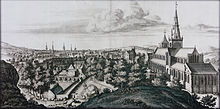Bishop's Castle, Glasgow

The Bishop's Castle, also known as Glasgow Castle and as the Bishop's Palace, was a medieval castle in Glasgow, Scotland. It served as the residence of the Archbishops of Glasgow until 1689.[1] Following the Glorious Revolution, the castle became the property of The Crown. It fell into disrepair during the 18th century, having been used as a quarry from 1755, and the site was cleared in 1789 to make way for the Glasgow Royal Infirmary.
History[]
Origins[]
The origins of the castle are unclear, but the first development was probably in the 12th century and it was first recorded in charters in 1258.[2][3] It had become an episcopal residence by the time of the Wars of Scottish Independence, when William Wallace recaptured the castle from the English in 1296. In 1301 the castle was garrisoned again by Edward I.[2]
In the 15th century a 5-storey keep was built by Bishop Cameron, this was later extended with additional fortifications and buildings, constructed by later bishops. Archbishop Beaton added a large corner tower, and Archbishop Dunbar built a round-towered gatehouse in 1544.[3] The central keep served as the residence of the bishop, and was called the Bishop's Palace. The castle played a role in the many political battles during the 16th century, including the protracted struggle between supporters of Mary, Queen of Scots, and her enemies. It changed hands six times between 1513 and 1570, and was occupied by French troops at one point. In 1544 it was defended against Regent Arran and in 1560 defended for Arran.
Decline[]
The castle fell into disrepair during the 17th century, despite an attempt at repair by Archbishop Ross in the 1680s,[3] and was gradually dismantled for its stone. It was finally demolished completely in 1789, to make way for the construction of the Glasgow Royal Infirmary. Foundations of the castle were discovered during excavations for the St Mungo Museum of Religious Life and Art in the 1980s. The museum building was designed by architect Iain Begg to reflect the style of the Bishop's Castle.[4] A stone from the castle, with a modern plaque, is located in Cathedral Square, marking the location of the keep.[2]
Notes[]
- ^ Athol L. Murray, "Preserving the Bishop's Castle, Glasgow, 1688-1741", Proceedings of the Society of Antiquaries of Scotland, volume 125 (1995), pp. 1143-1161.
- ^ a b c Mason, p.140
- ^ a b c "Glasgow, Bishop's Palace". Canmore. Historic Environment Scotland. Retrieved 13 March 2017.
- ^ "About St Mungo Museum". Glasgow Museums. Retrieved 13 March 2017.
References[]
- Coventry, Martin The Castles of Scotland (3rd Edition), Goblinshead, 2001
- Mason, Gordon The Castles of Glasgow and the Clyde, Goblinshead, 2000
External links[]
- Episcopal palaces in Scotland
- Castles in Glasgow
- Former castles in Scotland
- Demolished buildings and structures in Scotland